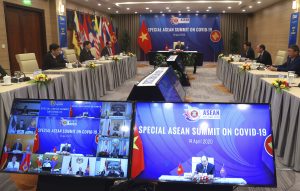The 37th ASEAN Summit was held in mid-November, together with the ASEAN +3 Summit, the East Asia Summit, and related meetings. Most reporting focused on the signing of the Regional Comprehensive Economic Partnership (RCEP), but the approach to ASEAN cooperation in the post-COVID-19 new normal set out by the ASEAN Comprehensive Recovery Framework (ACRF) and Its Implementation Plan are equally important.
Adopted at the ASEAN Summit, ACRF provides five broad strategies for the recovery: (1) Enhancing health systems; (2) Strengthening human security; (3) Maximizing the potential of the intra-ASEAN market and broader economic integration; (4) Accelerating inclusive digital information; and (5) Advancing toward a more sustainable and resilient future.
In mid-February, two weeks after the World Health Organization (WHO) declared COVID-19 a public health emergency of international concern (PHEIC), ASEAN issued a Chairman’s statement on the ASEAN collective response to the coronavirus outbreak, making clear that it was determined to work together on the pandemic response. Since then, the bloc has reiterated this stance of cooperation and solidarity at multiple venues, such as the ASEAN Defence Ministers Meeting (ADMM) on defense cooperation against disease outbreaks in late February, the 36th ASEAN Summit in June, and the 53rd ASEAN Foreign Ministers Meeting in September. With the ACRF, member states are again showing their commitment to working together under the ASEAN framework.
This commitment has produced some results in the health sector. In addition to internal ASEAN frameworks such as the ASEAN Health Ministers Meeting and the ASEAN Coordinating Council Working Group on Public Health Emergencies (ACCWG-PHE), which was created in March, ASEAN+3 frameworks such as the ASEAN+3 Health Ministers Meeting and the ASEAN +3 Field Epidemiology Training Network (ASEAN+3 FETN) have also been activated. In April, the ASEAN COVID-19 Response Fund was set up to finance medical equipment in the region and to share information on practices to minimize the impact of COVID-19. In November, member states agreed to establish an ASEAN Centre on Public Health Emergencies and Emerging Diseases. These initiatives primarily reflect the first strategy of bolstering the health system and the fifth strategy targeting a more sustainable and resilient future.
In the economic realm, ASEAN’s statements have called for support and rescue packages for specific industries, such as agriculture, fisheries, transport, tourism and hospitality. It has also cited the impact of the pandemic on cottage industries, small and medium enterprises, and the impact on migrant labor and other vulnerable or at-risk businesses and individuals. This awareness has translated into measures based on the second strategy of strengthening human security.
The fourth strategy, which focuses on digital transformation, is linked to the revitalization of ASEAN economies and a more proactive approach on the digital economy – already a focus for individual member states – at a time when human movement and contact are necessarily limited. Policymakers expect that economic integration in ASEAN and in the wider region, and the strengthening of the associated supply chains (indicated in the third strategy) will be the most effective approach to achieving a recovery and overcoming COVID-19.
As a result of the statement issued at the Special ASEAN Summit on COVID-19 in April, the Ha Noi Plan of Action on Strengthening ASEAN Economic Cooperation and Supply Chain Connectivity in Response to the COVID-19 Pandemic was adopted at the ASEAN Economic Ministers Meeting (AEM) in June. The plan proposes a policy of revitalizing ASEAN economies by strengthening supply chains within ASEAN and linking this to economic development to overcome the shock of the pandemic. Looking back, the vulnerability of ASEAN economies has been exposed by the interception of goods and people at national borders as a result of COVID-19. This has underscored the importance of strengthening supply chains, revitalizing flows of goods, investment and services across national borders, and making Southeast Asia a hub for trade and investment.
This demonstrates the bloc’s desire to continue its traditional growth strategy of economic development driven by globalization, even in the post-COVID-19 new normal. That makes the Regional Comprehensive Economic Partnership (RCEP) vital from the perspective of creating a foundation for developing the ASEAN growth strategy by involving Japan, China, and other key countries outside the region. It also explains the decision at the November summit to move forward with the ASEAN Travel Corridor arrangement, which was proposed by Indonesia.
Yet with few signs of the pandemic easing in Indonesia, the Philippines, or elsewhere, and amid concerns about the spread of infection in Myanmar, economic revitalization through economic integration contains elements that are inconsistent with the health systems initiatives outlined in the first strategy. Moreover, as ASEAN itself points out, there are concerns that development that is reliant on globalization will be to the detriment of vulnerable and at-risk businesses and individuals. To create a business-friendly environment for foreign capital, the hastily enacted omnibus law in Indonesia aims to harmonize plans to strengthen supply chains and economic integration across ASEAN. Yet it is also linked to weakening rights for vulnerable workers by relaxing employment conditions for laborers. In response, workers in Indonesia are already staging fierce demonstrations.
These concerns notwithstanding, ASEAN deserves high marks for setting out its vision for recovery and overcoming COVID-19. As China’s economic and political clout grows, and as its tensions with the U.S. worsen, Japan, the United States, Australia, and India are increasingly keen to see ASEAN countries working as one. The support of these regional players will help, but the key question for now will be the ability of ASEAN countries to get their post-COVID-19 recovery up and running.
Mie Oba is professor at the Faculty of Law, Kanagawa University.

































